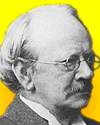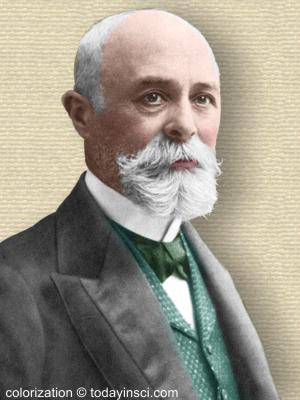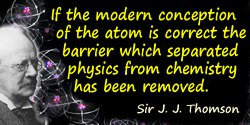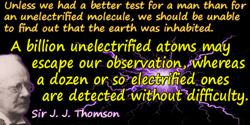
|
Sir J.J. Thomson
(18 Dec 1856 - 30 Aug 1940)
English physicist who investigated what were known as cathode rays, and discovered the electron (1897) and received the 1906 Nobel Prize for Physics.
|
Becquerel Rays
BY JOSEPH JOHN THOMSON, D.Sc, F.R.S.,
Cavendish Professor of Experimental Physics, Cambridge, England
[p.289] The discovery that Röntgen rays produce phosphorescence when they fall on sensitive substances naturally directed attention to the phosphorescence spontaneously emitted by certain substances of which the salts of uranium are the most conspicuous examples. It seemed possible that since these rays showed such remarkable power of producing phosphorescence, they might also play a part in other long-known cases of phosphorescence, such as that of uranium salts placed in sunlight, and that the phosphorescence might be caused by Röntgen rays emitted by the uranium itself.
The subject was taken up by Professor Becquerel of Paris, one of a famous family of physicists, three generations having distinguished themselves by their researches on phosphorescence. He took a quantity of a salt of uranium, and placing it near a photographic plate protected from light by light-proof screens, kept the uranium in a state of phosphorescence by continued exposure to sunlight. On developing the plate after the experiment had lasted several hours, he found a picture upon it, showing that something similar to Röntgen rays had been given out by the uranium. In all the earlier experiments the uranium was kept exposed to the sunlight, and was thus phosphorescing during the whole time of exposure. It happened, however, one day, that after Becquerel had prepared his uranium and photographic plates and exposed them to the sun, the sky after a short time became clouded over, and there was not light enough to make the uranium phosphoresce. Becquerel put his apparatus away in a drawer, and waited for better weather. The weather, however, did not improve, so that after waiting for some days Becquerel developed the plate, expecting, as the uranium had been phosphorescing for so very much shorter time than in the earlier experiments, to get, if he got anything at all, an exceedingly faint picture. To his surprise, however, he found that the picture excelled all those he had previously taken. It thus appeared that the uranium emit led the rays even when it was not phosphorescing. The uranium in this experiment had, however, previously been exposed to light, and it was possible that it might in consequence continue to emit some kind of invisible radiation long after the visible phosphorescence had ceased. To show that exposure to light had nothing to do with the effect produced by the uranium, Becquerel took a salt of uranium, dissolved it in water in the dark, and then recrystallized it, still keeping it in the dark. He found that this salt was just as active as salt which had not been shielded from the action of light. In this way he established that the emission of the radiation is a property of the uranium itself and is not dependent upon any previous stimulation.
This radiation from uranium, which, from its discoverer, is called Becquerel rays, produces effects very similar to those produced by Röntgen rays; thus it affects a photographic plate after passing through substances opaque to ordinary light, and it makes a gas through which it passes a conductor of electricity. Becquerel at first thought that his rays, like ordinary light, were refracted when they passed from one medium to another, and also that they could be polarized. Further experiments, however, by himself and others, showed that this is not the case. The Becquerel rays are in fact a mixture of Röntgen and cathode rays. The cathode rays (which have already formed the subject of an article in Harper's) have properties in some respects analogous to those of the Röntgen rays; thus they affect a photographic plate, and make a [p.290] gas through which they pass a conductor of electricity. The most important points in which the rays differ are, that the cathode rays are bent when a magnet is brought near them, while the Röntgen rays are not in any way affected; and, secondly, that the cathode rays carry with them a charge of negative electricity.
Professor Rutherford of Montreal showed many years ago that the radium emitted by uranium is of two types, which he called α and β. The α rays are easily stopped by thin layers of paper or of aluminum, while the β rays are much more penetrating. The β rays have lately been shown by Becquerel to be deflected by a magnet, and by Monsieur and Madame Curie to carry a charge of negative electricity; they are thus cathode rays; the α rays, on the other hand, are Röntgen rays.
In the article on cathode rays (Harper's, September, 1901) evidence was given that the cathode rays consisted of exceedingly small particles called corpuscles (very much smaller than the atoms of any known substance), charged with negative electricity, and moving at the rate of many thousand miles per second (the method of finding the speed of the corpuscles was explained in that article). When the cathode rays are produced in the usual way by sending an electric discharge through a vessel from which the air has been extracted (such as is used for producing Röntgen rays), the speed of the cathode rays depends upon the extent to which the air has been removed from the vessel. The highest velocity recorded for rays produced in this way is about 70,000 miles per second. Large as the velocity is, it is greatly exceeded by the velocity of the cathode rays spontaneously given out by uranium; while another substance, radium, emits rays moving at a still greater speed, velocities of over 120,000 miles per second having been recorded by Becquerel for the cathode rays given out by radium; a particle travelling with this velocity, and starting from the earth, would reach the moon in two seconds. Among all the mysteries associated with matter, few, if any, are more striking than that afforded by these substances, in no way remarkable in appearance, which, without provocation and without intermission, emit projectiles which travel at a rate compared with which that of the fastest bullet is absolutely insignificant.
After the discovery of the peculiar property possessed by uranium all the known chemical elements were tested to see whether there were any others which possessed similar powers; one and only one was found to do so; this is thorium, a substance largely used in the manufacture of incandescent gas-mantles. This property of thorium was discovered by Schmidt.
The activity of artificially prepared salts is strictly proportional to the amount of uranium they contain. Monsieur and Madame Curie, who examined a large number of native minerals containing uranium, found, however, that several of these, and especially the pitchblendes (although only a fraction of their bulk consisted of uranium), were much more active than pure uranium itself; one of the minerals tested—chalcolite— was prepared artificially by Monsieur and Madame Curie, and the activity of the product was found to be normal—i. e., proportional to the amount of uranium it contained, and very far below that of the native mineral. It seemed, therefore, probable that these minerals contained some unknown substance much more active than uranium itself. It was to the problem of separating this unknown substance that the Curies applied themselves. The mineral they selected for this purpose was pitchblende, and their method was to separate from this substance by chemical means one constituent after another, and then test the portion thus separated for radio-activity. In this way Madame Curie found that along with the bismuth separated from the pitchblende there comes away a very radio-active substance, which, in honor of her native country, she called polonium; while, with the barium taken from the pitchblende, the Curies, in collaboration with Monsieur Bemont, showed that there was an intensely radio-active substance, which they called radium. Later, Monsieur Debierne has obtained a third substance, which seems closely to resemble thorium, and which is called actinium. The amount of these substances in the pitchblende is exceedingly small; it is probable that there is far less in proportion [p.291]of any of these substances in pitchblende than there is gold in sea-water, and it is only through indefatigable zeal and great experimental skill that the Curies have been able to obtain their marvellously interesting results.
The separation of these substances from pitchblende would have been impossible had it not been for the marvellously delicate test of radio-activity, and therefore of the presence of radioactive substances, afforded by the electrical conductivity produced by them in gases. Making use of this property, it is possible to detect quantities of these substances millions of times less than could be detected by chemical analysis, and thousands of times less than could be detected by spectrum analysis; indeed, of the three substances, radium, polonium, and actinium, obtained from pitchblende, radium is the only one which has been detected by chemical or spectroscopic means, and the Curies found that they could not detect radium by the spectroscope until they had more than five thousand times the amount which gave very appreciable indications on the electrometer. It may confidently be hoped that the possession of a test of such marvellous delicacy will enable us to follow out and study the details of the changes which take place in these radio-active bodies when exposed to the effects of physical and chemical agents with a thoroughness which has not been possible with other substances, for which only the older and much less delicate methods have been available. We shall see directly that this hope has already, to a considerable extent, been realized.
By successive purification of the barium obtained from pitchblende, the Curies have obtained radium of extraordinary radio-activity—more than 100,000 times that of uranium—and which, even when enclosed in lead a quarter of an inch thick, can produce greater effects than uncovered uranium. The radium is self-luminous, shining with a bluish light; it, like Röntgen rays, makes a sensitive screen phosphoresce; it shows the bones in the hand, and is so vigorous that it has produced sores on those who have incautiously carried it about their persons. The radium emits negatively electrified particles with a velocity in some cases approaching that of light. This continued emission of particles from the radium of course implies that the radium is losing mass and energy. The loss of mass is exceedingly small; from the results given by Curie for the amount of negative electricity emitted by the radium it follows that the loss of mass would only amount to about one-thousandth of a milligram in a million years for each square centimetre of surface. In consequence of the tremendous velocity with which the particles are projected, the amount of energy radiated is quite an appreciable amount, being sufficient, if converted into heat, to melt in a million years a layer of ice of the same area of the radium and more than a quarter of a mile thick. This loss of energy goes on without intermission, and has been going on—as far as we know—for whatever number of millions of years the radium may have existed.
There must have been some very considerable store of energy at the disposal of the radium to enable it to keep up this rate of radiation, and the very interesting question arises, what is the nature of this energy, and how is it stored? A satisfactory answer to this question has, I think, been given by some quite recent researches made by Professors Rutherford and Soddy of Montreal. Before describing their experiments, it will be well to consider two investigations which led up to them. The first of these was made by Sir William Crookes. By chemical means he obtained from ordinary uranium two constituents, one of which affected a photographic plate, while the other did not. The second investigation was made by Becquerel, who took a radio-active solution of a salt of uranium and dissolved in it a salt of barium. He then precipitated the barium from the solution, and found that by so doing he had transferred the radio-activity from the solution (which still contained the uranium) to the precipitated barium: fortunately he kept his solutions, and on examining them about twelve months later he found that the uranium solution, which he had made inactive, had recovered all its former activity; while the barium, which had appropriated the radio-activity of the uranium, had not been able to retain it, and had become absolutely inert. The [p.292] explanation of this remarkable occurrence is given by the experiments of Rutherford and Soddy on another radioactive substance—thorium. They were able to separate from thorium its active constituent, and obtained two products, one exceedingly minute in quantity, but intensely active, which they called thorium X; the other, which contained practically the whole of the thorium, was almost inert.
This was the state of things when the products were separated. It did not, however, continue for long, for the active thorium X began at once to lose its activity, and the other product to regain it. After a few days the thorium X had become quite inert, while the thorium had regained its old activity, and afforded fresh supplies of the thorium X. It seems evident from this experiment that thorium X is continually being produced from the original thorium, but as its radio-activity is not permanent, the radio-activity of this mixture does not increase beyond a certain point; the gain derived from the production of fresh thorium X being balanced by the loss due to the death of some of that previously produced. We may illustrate this by simple analogy. Suppose radio-activity were a property possessed by all infants less than one year old, and by no one else: then, though fresh infants are continually being born, the radio-activity of the community will not increase beyond a certain point, as the gain from the new children will be balanced by the loss of those who get too old to be radio-active. If the birth-rate of this community were constant, its radio - activity would evidently be proportional to the number of children born in one year. Now suppose that all the infants were suddenly removed to a gigantic creche in another district: the effect of this would be to deprive the original community of all its radioactivity, while the creche would be intensely radio-active in proportion to its population. The birth of fresh children would gradually restore radio-activity to the community, while the superannuation of those in the creche would make its radio-activity decay. In six months half the children in the creche will be overage, so that its radio-activity will be reduced to one-half; in the same time the original community will have recovered half its radio-active population, and therefore half its original radio-activity. Thus the time taken for the separated substance to lose half its activity ought, if this analogy is correct, to be equal to the time taken by the original substance to recover half its activity. This very simple test has been applied by Rutherford and Soddy, and found to be satisfied with great exactitude. We see now the source from which the energy required to sustain the radiation is derived; the radio-active substance is undergoing a continuous transformation into a state in which it has less energy. There is thus a continuous loss of energy by the substance, the energy being carried off by the radiation.
Ordinary thorium is thus steadily being transformed into the active thorium X, while this is continually passing into some inactive form. What this inactive form is we do not know, and its elucidation offers a most interesting problem, rich in possibilities. This inactive form must be continually accumulating, and although its rate of formation is probably exceedingly slow, we may hope that there may be enough of it in the minerals in which thorium occurs to be detected by ordinary chemical means; a careful examination of these minerals to see whether there is any other substance invariably present with the thorium might lead to its detection. It would also be interesting to see whether artificially prepared compounds of thorium change in any way as they get older. We have every reason to believe that radium goes through changes analogous to those of thorium, as when radium is freshly prepared it is not nearly so active as it subsequently becomes.
Rutherford found that thorium, besides giving out Röntgen and cathode rays, gave out a radio-active gas, which he called the thorium “emanation.” The radio-activity of this emanation only lasts for a few minutes. Rutherford and Soddy have shown that it is only given out by the active thorium X, and not by thorium when in its normal state. This emanation in its inertness resembles the new gases argon and helium; it has not yet been made to combine with any other [p.293] element. It is remarkable that the minerals in which helium occurs invariably contain radio-active substances, and the idea naturally suggests itself that helium may be very closely connected with the gaseous emanation which these radio-active substances are continually giving out. Radium also gives out a gaseous radio-active emanation, whose activity lasts much longer than that from thorium.
Rutherford and Monsieur and Madame Curie have shown that these emanations are not only radio-active themselves, but that they possess the remarkable property of making radio-active any substance with which they have for some time been in contact. If the substance is negatively electrified whilst in contact with the emanation, the radio-activity induced in it is very much increased. The intensity of this induced radio-activity does not depend to any great extent on the nature of the substance. A piece of paper can be made as strongly radioactive as a piece of metal. This induced radio-activity only lasts for a few hours—the induced radio-activity due to the emanation from thorium lasting longer than that due to radium, although the activity of the emanation from thorium is much less durable.
Elster and Geitel made the very remarkable discovery that substances could be made radio-active without the aid of thorium or radium; all that is necessary is to hang them up in the open air, or in a very large room, and charge them strongly with negative electricity; after a few hours they become radio-active. Elster and Geitel have taken photographs with the scrapings of a copper rod, which had been treated in this way. The earth itself is negatively electrified, and the natural electrification on pointed conductors connected with the earth is sufficient to make them radio-active without further electrification. Thus the points of lightning-conductors, the pointed leaves and spines of trees, are always radio-active, and C. T. R. Wilson has lately shown that freshly fallen rain is so too, and that it retains this property for about an hour. Elster and Geitel thought that this induced radio-activity indicated the presence of yet another constituent in that already very mixed body the air, the new constituent being, like thorium or radium, radio-active.
The writer has, however, recently made some experiments which show that we can account for this induced radioactivity without having recourse to such an hypothesis, and that radio-activity may be produced by suitable treatment without the help of radio-active substances. It is to be remarked that this radio-activity is produced when the body is negatively electrified; its origin can, I think, be explained in the following way: We know that the air always contains small bodies, called ions, charged, some with positive, others with negative electricity. When a negatively electrified body is placed in the air the positively electrified ions are attracted towards it. Some of these, but not all, will give up their electric charge to the body; those that do not will accumulate close to the surface of the body, forming a layer of positive electricity round it. This layer of positive electricity will attract the negative electricity in the body, and when the attraction is very great the negative electricity will be pulled so vigorously that it will shoot out from the body with great velocity. Now negative electricity moving with great velocity is cathode rays, hence the body will give out cathode rays, and will thus be radio-active. Thus to make a body radio-active all that is necessary is to get a layer containing a large quantity of positive electricity close to the surface of the body. We can, in this way, make radio-active substances without the use of any material that is intrinsically radio-active.
It is thus, I think, that the leaves of trees and the countless objects on the surface of the earth which are radioactive acquire this property; they are, in fact, cathodes, discharging cathode rays into the air. Thus cathode rays, which have only comparatively recently been discovered, and then by the help of most elaborate apparatus, are in all probability so widely distributed and occur so frequently that there is hardly a patch of ground on the earth's surface which does not contain an active source of these rays.
- Science Quotes by Sir J.J. Thomson.
- 18 Dec - short biography, births, deaths and events on date of Thomson's birth.
- Cathode Rays - by J.J. Thomson (30 Apr 1897) announcing his discovery of what is now known as the electron.
- Radio-Activity: A New Property of Matter - article describing Bequerel's research, written only a few years after his discovery of radioactivity, from Harper's Magazine (1902).
- Science Quotes by Henri Becquerel.
- 15 Dec - short biography, births, deaths and events on Becquerel's date of birth.
- Radioactivity: A History of a Mysterious Science, by Marjorie C. Malley. - book suggestion.
- Booklist for History of Radioactivity.
- J.J. Thompson And The Discovery Of The Electron, by E. A. Davis and Isabel Falconer. - book suggestion.
- Booklist for John Joseph Thomson.








